#and i'll try to get neem oil
Text
My baby bell peppers have spider mites and I'm so sad
#plantblr#indoor plants#bell peppers#the early signs of spider mite infestation mimic nutrient deficiency#and i fell for it#because i thought i would be spared from pest problems indoors#and now i'm upset#i've been having literal recurring nightmares about bad things happening to my plants#i had to cut off a bunch of leaves#i'm cool with it if it means they'll be okay#but the bugs are still there#i'm treating with dilute alcohol spray and physically removing the webbing#and i'll try to get neem oil
1 note
·
View note
Text
Do you think Thomas Zane grew his own weed and mushrooms?
#I had the stupidest funniest idea but it involves so many characters I'll let it simmer down for a while#me daydreaming while trying to get rid of aphids:#Darling accidentally developed an altered formula of potassium soap with neem oil
55 notes
·
View notes
Note
Hey, I just wanted to let you know that its likely not your fault with the monstera. Propagation is extremely difficult, especially in water. It all comes down to luck of the draw in the end. Could be the host plant had an underlying issue and the cutting couldn't hack it. I find I have a lot more luck with soil propagation than hydroponic but if you try again with a monstera, I'd get some neem oil to keep on hand. Fungus gnats love the conditions monsteras need to thrive and they're as annoying as fruit flies
aaa ty for this i think im gonna stick to just propagating pothos for now lol, i still have no clue what went worng bc the cuttings had no problems with starting to sprout new roots but. the leaves were just spotted brown and shriveled anyway 🫡 and ty for the neem oil advice!! i had it already against fruit flies i'll keep it ready to use in case of fungus gnats too
15 notes
·
View notes
Text
Hello and Good morning, its Time for a reply blog :)
@boondogs I absolutly will share when I find a good way to get rid of the squash Beetles. I've had issues with the beetles every year I've planted zuchinni, grey squash or yellow squash (even for a Few different pumpkin varieties) Honestly i totally spaced on trap crops for this pest issue! I've heard of them and used a few times but mostly for aphids.
If you wouldn't mind sharing, is it hubbard squash your using for your trap crop?
I looked up some other trap crops too, nasturtium, catnip, garlic, onions, radishes, marigolds, calendula, and tansy are a few mentioned. I've used marigolds on school crops before for other pests [potato beetles mainly] and they were both beneficial for removing pests and good food for pollinator species (plus they are edible, can be used for tea and in soap-making) in addition to being just pretty plants.
Last time I wanted to try neem oil, ive heard it works to smother the eggs and bugs? But wasn't able to find any when i needed it. I do have some spray neem oil now so I'll be testing that out when they show up again.
A recent one I saw, works on the eggs mostly. Take a lighter, the super mini torch type works best. Flick it on and burn the eggs. I've done this twice with other eggs that look like pest eggs. A little burn is better than a total infestation.
Another tip from a gardener friend, is to go out in the morning while it's still pretty cool, maybe even dark out with a bucket of soapy water. Flick every adult/younger life cycle into the soapy water, if possible cap and shake so they can't escape. It works, if you get all of them bit is very time consuming and physically tiring with large amounts of plant. For this method, try to cardboard placed out the night before and turn over in the morning, will help a lil bit.
Unfortunately since where im at doesn't really get freezing temperatures (very rarely frosts even) the leftover nymphs/adults that are leftover don't die. Squash bugs overwinter as adults under plant debris (this is why solarizing and keeping the garden clean is important, I'd like to leave the leftovers for soils amendment but cant.) Soil clods,rocks, log piles and buildings are all potential hibernation spots.
I've been avoiding squash plants for awhile because of this. Which sucks cause most squash-plants can provide a lot of food for fairly minimal input. As soon as I've got dirt for the new bed tho I'll likely be planting a few zuchinni.
🌱🌱Happy Homesteading all 🌱🌱
#homesteading#self sufficient living#thestudentfarmer#studentfarmer#self sufficiency#food#garden#gardening#low waste#pest control#garden pests#zuchinni#grey squash#yellow squash#pumpkin#pumpkins#chickens#trap crops#urban homesteading#urban gardening#urban farming#human right to clean food#right to grow food#right to grow#food is a human right#garden q & a
4 notes
·
View notes
Text
There have just been so many tiny irritating things about today that keep piling up.
Tried to plan the trip we have to take in a few months and found out it's not going to work for they wanted it to, so it's got to be entirely replanned.
Dropped mother in law back off at her place and found out half her trees are infected with pests, so I'm going to have to find time soon to start treating them.
Had to tell my partner to not go into her backyard because there was a swarm of bees around a plant growing on the hill. She got mad about this, despite the fact that she knows her kid is allergic to bees (and almost died as a kid from getting attacked multiple times). I only said something to warn them to be careful, not because I want the bees gone (but I am going to have to evaluate if it's a hive or just because it's flowering and make a call from that).
Went to the hardware store to get sprays to get started on the trees (the stuff I really want I'll need to go to a specialty store but I don't want to wait for the first application) and had a bottle of concentrated neem oil leak all over my arm. Also had a guy run into me with a cart and then his wife decided to lean on me to reach for something on a higher shelf. Like, why? Why must you do that?
Assuming we don't go over tomorrow so I can get started, the first chance I'll have is Friday. I'm going to have to drag a ladder over (because she only has a rickety step stool), suit up in protective gear, trim multiple branches and leaves off, and douse several sixty years old citrus trees to try and save them. I have multiple doctor appointments this week and my covid booster next weekend, so time is very tight right now.
Everyone over there kind of shrugged it off, but they keep sending me fruit and I don't want my plants getting contaminated. So I've got to get this under control now or else.
1 note
·
View note
Note
diatomaceous earth or coffee grounds can help deter them, doesn’t kill them though. Neem oil maybe because that’s used as a cure all?
the first one is too expensive for me and i've tried coffee grouns :( Never heard of neem oil helping for snails but i've been meaning to get some to prevent infections frommmy neighbors so i'll try!!
1 note
·
View note
Text
those flipping flea beetles and my eggplants. 😭
i swear, if it's not one thing, it's another. they're so stunted and I have a feeling the smaller ones are gonna die. they look so bad.

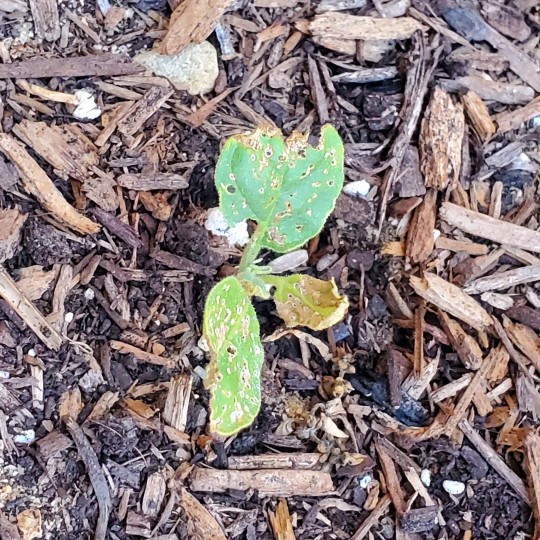

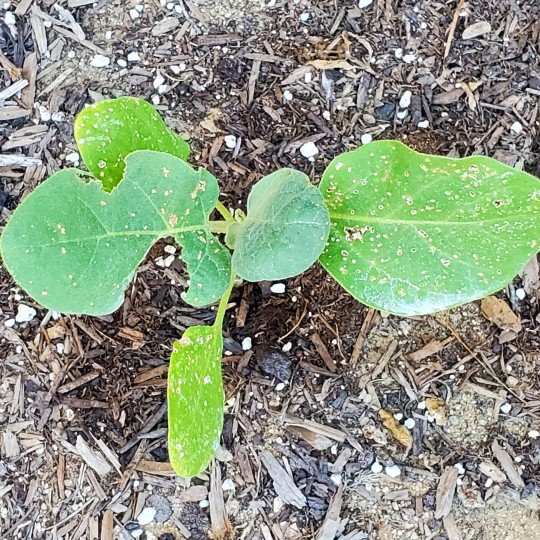
and the culprit:
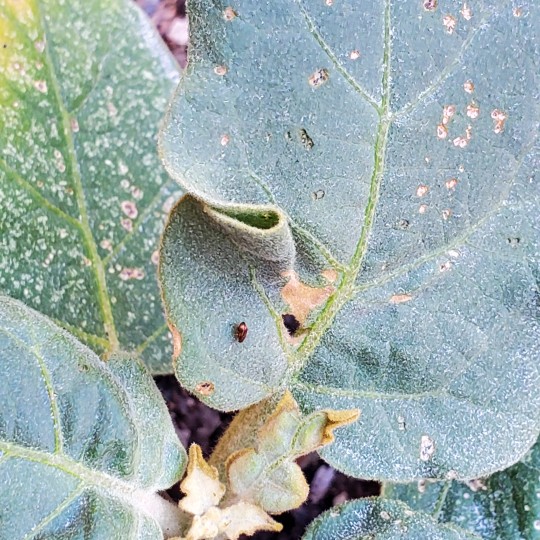
i literally JUST sprayed the plant down with a mix of water, DE, Neem oil, and soap... so WTF?
I heard coffee grounds repel them, so I'm off to get some to sprinkle around it.
next project was the peppers, which I moved over. the cherry peppers have a lot more room, and the 2 serrano are in it's place.
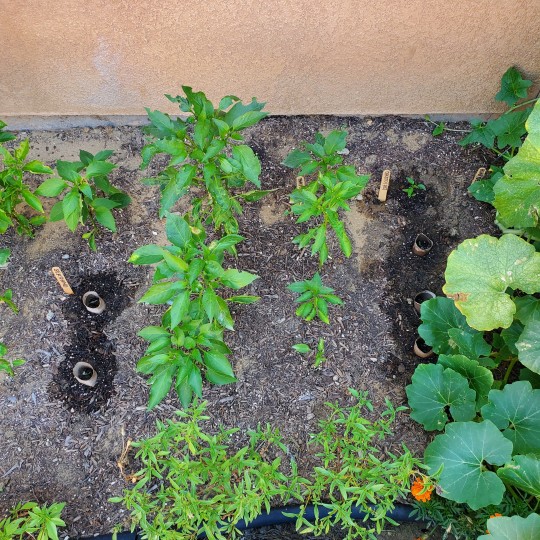
i hope I didn't shock them too much. i started to figure it was maybe better to do it when they had simple roots instead of when they're older with more complicated roots. Having the soil plug attached helps.
*we shall see*
trellised the cucumbers.

i believe I have 4 plants now. so 2 are a trailing situation in the back and the other 2 are going up on opposing sides of the trellis. i like how this gives me more access to roots.
while moving over the dill, I caught 2 green worms, probably munching on the radish leaves. 🐛
*smoosh*
and... my strawberry leaves are browning.
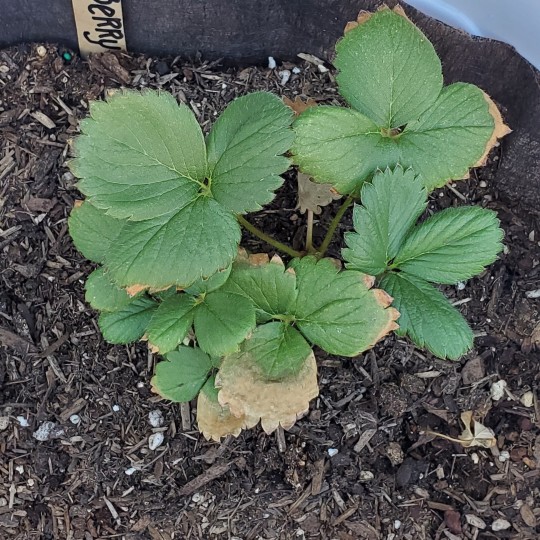
i may be watering it too much? they have new leaves coming through, so I might just lay off watering them at all and let them dry out a bit.
i think I have an issue with over watering my plants, tbh. need to cut that shit out.
condensed my soil for my more mature plants and readied a few pots with soil for the nursery plants. I'm excited and hopeful for the pineapple sage because I don't think what I have is coming back. i mean, I can keep trying, but I think it's toast.
something nibbled my cilantro. definitely a 🐛 but I didn't see anything in the pot. cucamelons are growing tiny secondary leaves. I want to make sure they're good and mature because the area has 🐛 and the cutworm moths that like to hang out in that area. the seeds... i think instead of putting them in a separate pot, I'll just wrap it in seedling starter soil and add it into the same pot.
dill is sprouting well. Korean mint is doing good, and so far, so is the rosemary, both in the pot and in water... though I don't know if I want to keep the old roots in water, or clip it all off and try to grow fresh roots from the stem.
0 notes
Text
Reading up on foods, supplements and even activities that can improve your health after you've been exposed to mold.
One supplement suggestion was spirulina. That is used for many afflictions and I've wanted to get into it for a while. The only problem is it reduces blood pressure and mine is already low. It would be a good natural source of iron, but not B12.
If I want more energy, I should try more B vitamins and an iron supplement plus something to help them absorb. I believe I also wanted to try bacopa for brain fog again at some point.
Chlorella is another type of algae that compliments spirulina.
Another one that looks good is oregano oil. I might have dried oregano to cook with already too. I might be confusing it with basil and thyme, though. I should check. If there's no oregano, I will get a bulk container next time I can put more money towards cooking. Speaking of thyme, that one comes in an oil too.
I am all out of lavender as of last night. Lavender is great at fighting mold/fungi toxins.
Clove oil is also recommended, as is plenty of garlic. A lot of sources are saying to eat more vegetables (especially leafy greens), healthy fats like olive oil, a lot of herbs/spices, raw nuts and seeds, meat, and various teas.
One tea that helps is dandelion. Another is Pau D' Arco. Lemongrass is also useful.
A supplement that comes up when I Google "antifungal herbs" is neem.
I found one blend of tea that uses mullein, red raspberry, sage, and goldenseal. That sounds delicious. I saved the link in my notes app in case I ever have $25 to spare on stuff like this. lol
Apple cider vinegar every day can help a variety of conditions too (including candida.) If it's not mold exposure, I could possibly be at risk for candida overgrowth but I don't know how to check.
Sorry, a lot of this probably sounds like fake science or a bunch of hippie woo but I'm willing to try anything to feel healthier and be more productive.
As for activities, anything that makes you sweat is good - like "hot" yoga and swimming, etc. I'll keep that in mind when I quit gabapentin again. I'll embrace the extra sweating as a purge of toxicity.
#journal#personal#food#mold#mold exposure#antifungal#candida#cleansing#healthy cooking#fibromyalgia#chronic pain#chronic fatigue#brain fog
1 note
·
View note
Text
Carnivorous Plants and the Things I Know About Them
I've been kicking around the idea of making a post like this and I figured it was of enough general interest to folks on Tumblr to go for it.
So
One of the things I do is grow carnivorous plants, like these




From top left to bottom right we have a Venus Flytrap, a North American Pitcher Plant, a Sundew, and a Butterwort. All of these are pictures I've taken of plants during the growing season.
Now if you look at these weird looking plants you probably wouldn't expect them to be native to North America, but they are. You can find pitcher plants all over the southeast up to the northeast into Canada, flytraps in the Carolinas, and butterworts and sundews all over the continent.
These plants are a lot of fun and easy to grow once you understand their requirements, but before we get into that, I want to take a moment and explain how they came to be in the first place.
To keep it short, carnivorous plants are carnivorous because they grow in soils that are lacking in the nutrients plants need to put out new growth. Because of this, they evolved to find their nutrients a different way - by luring, trapping, and digesting insects. While these plants still photosynthesize, they supplement this with the nutrients they absorb from insects.
Now that we've got that out of the way, I'm going to go into the basics of growing them, point by point. A short disclaimer - I'm specifically talking about temperate North American plants, since they're what I have experience growing. I can provide basic info on how to take care of tropical plants like the southeast asian pitcher plants, but as of this post I don't have experience with them yet.
Soil: For carnivorous plants, a good soil mixture is a must. These plants grow in nutrient-poor marshes, and the soil they call home is constantly wet. The main ingredient in basically any carnivorous plant soil mix is sphagnum peat moss, which is slightly acidic. The second part of the mixture is often perlite or horticultural sand. Some nurseries use a mix of equal parts peat and perlite while others use 80% peat and 20% perlite, but I've had success with both. The most important thing to ensure is that your soil doesn't have any fertilizer added to it. Because carnivores grow in low nutrient soil, any kind of medium that contains fertilizer can actually kill them.
Water: The other vitally important part of the equation (and the one that kills lots of plants when incorrectly applied) is water. Generally, unless your tap water is soft, water carnivores with distilled or reverse osmosis water. The minerals in tap water or even bottled drinking water can eventually build up and kill your plant in the same way fertilized soil does. Carnivores love waterlogged soil, and some even get flooded in nature. To approximate this, set your plant in a tray of water no more than an inch or two high. This ensures your soil stays wet without having to constantly water it.
Containers: Plastic pots are your friend. Avoid terra cotta clay pots, since they can leech minerals into the soil and also tend to dry out your substrate faster. Glazed clay containers can also work. If you're using the tray system, make sure to buy pots with drainage holes, so the water can get in. Also, a trick that lets the water in but keeps the soil from escaping is to line the bottom of the pot with long-fibered sphagnum moss. If you go with an undrained container, make sure to keep the soil wet at all times, but allow some of the water to evaporate in order to keep the water table fluctuating.
Sunlight: Since carnivores evolved their leaves to catch insects, they're pretty poor at photosynthesis. As a result, these plants love sun - the more the better. Many a store bought flytrap has perished as a houseplant due to lack of sun, so if you can, put these plants outside, in the sunniest spot you can. Generally, it's good to give most carnivores around 6 hours of sunlight per day. Many can get by with 4, but they don't often thrive with that amount of light.
Dormancy: Plants that grow in temperate or warm temperate climates tend to buckle down and hibernate during the late fall and winter months, conserving energy until spring. Generally speaking, the large traps die off, or in some cases the plant dies down to the roots, or forms a small bud that rests on the ground. Plants grown outside respond to colder temperatures and shorter photoperiods, while plants grown inside usually need some help. If you're growing your plants on a windowsill or in a terrarium, move them somewhere cold or cut down on their heating, and also diminish the amount of daily light they receive. You can also slow down on watering, though they still need some water to get by.
Temperature: Temperate and warm temperate carnivores can tolerate a wide range of temperatures, despite what you might think. My pots survived the freak snowstorm the Pacific Northwest got this February without a single dead plant. Most species can tolerate temperatures up to 100 degrees Fahrenheit and down to 20 degrees, though not for prolonged periods of time. If you see long spells of hot or cold weather coming, try and move your plants to a protected area until they pass.
Feeding and Fertilizing: Now I know what you're thinking. Fertilizer? He just told us that stuff was death! And it often is, but there are ways to fertilize your plants. Generally, a fertilizer made for acid-loving plants can be diluted and applied to the leaves during the growing season. I use Maxsea 16-16-16 on plants that are too young to easily catch prey (diluted down to a half teaspoon per gallon) and haven't had issues. Try not to spray the soil unless you frequently water your plants from overhead, as the dreaded mineral buildup can still occur. That said, if your plants are outside, they'll fertilize themselves. You can also "feed" your plants insects using tongs - keep in mind that some plants require their prey to be alive in order to secrete digestive enzymes. I'll get into prey in more detail in other posts about specific types of plants.
Flowering and Propagation: For a lot of carnivorous plants, flowering is an exhausting effort that tends to deplete the energy they would use creating traps. As a general rule, if you're not interested in seed, clip the flower stalks off. Many plants can be propagated through leaf or root cuttings, which produce genetically identical plants. Some plants also clump and form their own divisions over time, meaning all you need to do to get more is wait for a year or so, depending on the age of the plant.
Pests: Carnivores can be targeted by various pests. For insecticides, I've seen neem oil recommended, as its generally less harmful to the plant and the environment. I haven't had to make much use of these yet, so my information on insecticides is a bit of a blind spot. Generally, try and stay away from soap insecticides and aerosols, and stick to less concentrated varieties. If you're dealing with squirrels or rodents digging up your plants, I found a generous sprinkling of cayenne pepper around the plants works wonders, and does no harm to the plants.
This is a basic rundown of carnivorous plants and how to take care of some of them. I must stress there's a ton of information out there - this post is geared more towards starter plants that are fairly forgiving and simple to grow.
So why grow carnivorous plants when you can just go out and buy some petunias?
They're active: Carnivores are showy, unique plants that can move on their own through some incredibly unique and complex evolutions. Watching a Venus Flytrap snap shut or a Sundew curl around an insect is a truly special thing to see.
They're a conversation piece: The relative rarity of carnivores in cultivation means the average person doesn't know much about them, despite maybe having heard of a Venus Flytrap before. A 12" pot of flytraps, sundews, and pitchers is a surefire way to grab attention.
They can control certain pests: Carnivorous plants can act as natural pest controllers. North American Pitcher Plants gorge themselves on flies and wasps, and considering some pitchers can grow over two feet tall, they can hold plenty of them. Sundews and butterworts specialize in catching smaller prey, such as fungus gnats, fruit flies, and even fleas. These plants can work as limited, natural pest controllers, though they won't eradicate a yellow jacket nest for you.
They're endangered in the wild: The wet, marshy habitats carnivores call home are rapidly dwindling due to improper land management and development. Some are nearly extinct in their home ranges, kept going through dedicated nurseries and attempts to naturalize them in other locations. By caring for carnivorous plants, you're raising awareness of these unique, underappreciated organisms and aiding in their conservation by keeping them alive.
Phew, I realize this was a lot, but I hope it was a fun read! Let me know what you think about carnivorous plants, or if you have any questions about them. I'm going to try and go into more detail on specific plants later, but for now, I wanted to bang out the basics.
If you're looking for more information, Flytrapcare.com is a great forum, and the r/savagegarden subreddit is very helpful as well. For books on the subject, the Savage Garden by Peter D'Amato is the go to source. Nurseries I've used and can vouch for are Sarracenia Northwest (located in Oregon) and California Carnivores (located in California).
25 notes
·
View notes
Text
i helped my mom vacuum and clean some things in her room and despite it being just regular ol' cleaning, I somehow managed to wrench my shoulder.
Now it's all stiff and painful, and all we have for pain relief is Aleve and Advil bc I ran out of tylenol. I recently read that actually, anti-inflammatory meds can slow down the healing process in like sprains and wrenched joints etc. I took some Advil anyways bc I need to try to sleep tonight at least a little.
In garden news, there will probably be NO beets lol and very few if any radishes because my lack of remembering how gigantic zucchinis and squash get means the beets and radishes became overshadowed by the gigantic leaves. Zucchini and Squash are having a buttload of male flowers but I don't see any female flowers. *shrugs* I dunno! But I see plenty of buzzing around of bees and such so it should be okay once the female plants bloom
Tomatoes look ok, the parsley is looking way better than I expected, my borage plant is doing all right and the seeds I plants are starting on their third set of leaves. The bee balm plants - one is doing GREAT, the other looks like it had been pulled out by something and had a few bent stems, I replanted it and propped the stems up but its looking a bit shabby. The lower unbent stems look much better though, so I may just end up cutting the bent stems because it seems they're too damaged to grow properly, and that way the lower stems will be able to grow better.
Unfortunately, one of the tomatoes i have in a container developed an issue.

I have no idea what exactly this could be. It could be Early Blight, it could be something called Tomato Spotted Wilt Virus. If its blight, then it's fixable. If its the virus, it can be an issue that can be passed on to other plants.
Thing is, it's in the container with another tomato, and that one shows NO signs of anything. TSPWV is transferred by thrips, that can infect a tomato (or any plant) when they feed on it or whatever. So if this one has it, and the other one doesn't...?? Maybe it's the blight.
Anyways, I trimmed off all the affected branches, and sprayed all the container tomatoes with Neem Oil just in case. Won't hurt.
I'm going to get a standing garden bed (maybe a galvanized steel one) and plant beets and radishes in it later in the season, like mid-August maybe to harvest in the fall. (What if we have barszcz made from home-grown beets for xmas this year? that would be awesome) Next year I want to plant the zucchini and squash in the standing garden bed and let them go wild in there. use the on-ground garden bed for carrots, beets, radishes, dill, parsley root, that sorta stuff. Maybe POTATOES NO WAIT i'll get maybe some of those felt bag things for the potatoes

Next year I want to try potatoes, like the little yukon gold like potatoes. Maybe the ones that are like purple too.
Anyways enough talk I need to sleep
1 note
·
View note
Note
I recently moved and found a rose growing in my back garden. It's clearly having a hard time: some sort of insect has been at the leaves, and it's trailing like it might be a climbing rose, but has no trellis to support it. Despite all of it's problems, it's trying it's best- even has a hot pink flower in bloom (how I found it amid the hostas). I'd like to try to help it. Any advice or books/websites you'd recommend? I can do vegetables, but I'm new to roses, and worried I'll kill it.
Is it getting enough sun? The ‘found it among the hostas’ thing indicates it might not be. Roses like full sun, the more the better. If it’s shaded a lot it might be good to move it somewhere sunnier.
Now, I’m not going to link you to a website because most of them will make it way more complicated than it really is. Roses like sun. They like rich soil with some compost in it, but will tolerate clay. They like to be kept moist, but don’t like to stand in a pool of water all day and will tolerate some drought if they’re tough own root roses. That’s it. If yours is tough enough to survive neglect like being lost in a hosta patch, it’s tough enough to not need fussing or special fertilizing every 2 months or surgically precise pruning.
(Actually, no plant I grow needs much fussing. I’m a firm believer in Darwinian selection in my garden; if you can’t hack it, you go to the Big Compost Pile In the Sky. Also, the actual compost pile.)
As for the insects...Neem oil will take care of most chewing insects, is harmless to bees and butterflies, and is biodegradable. Smells like old onions, but that dissipates quickly once applied. You can let climbing roses sprawl if you have a space with room (Which Felony is currently doing; I moved the coral bells and Widow’s Tears so she could have the whole area, and she’s happily sprawling out over it) or you could tie it up against a trellis or stakes or a fence.
81 notes
·
View notes